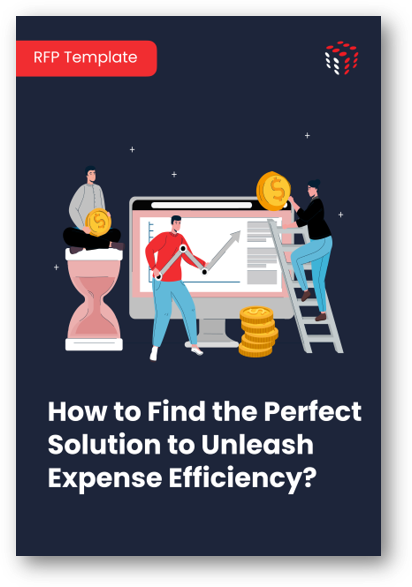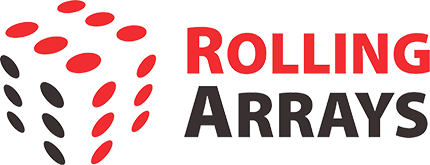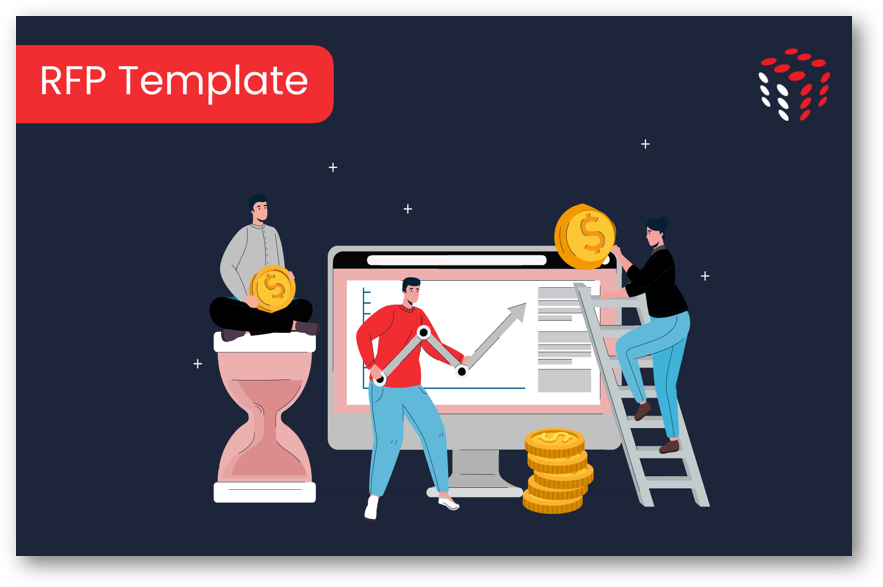
Whitepaper
The Ultimate Buyer’s Guide to Enterprise Expense Management Software 2024
RFP Template Included


Table of Contents
RESOURCES > WHITEPAPER > The Ultimate Buyer’s Guide to Enterprise Expense Management Software 2024
Managing business expenses efficiently is critical for companies to control costs, maintain compliance, and promote productivity. However, organisations often need help with manual, disjointed processes for expense reporting, approvals, reimbursement, and accounting. This leads to errors, policy violations, lack of visibility, and frustrated employees wasting hours on paperwork.
Companies spend about half a million dollars and 3,000 hours processing and correcting expense reports yearly. Each expense report costs an extra $52 to fix. This is according to the Global Business Travel Association.
A study on employee attitudes towards expense reports found that:
- More than 33% of employees don’t report expenses because they don’t think it’s worth the effort.
- Another 33% of employees feel financially insecure when paying company expenses out of pocket.
- About 25% of employees have cancelled or postponed meetings to avoid paying for company expenses out of pocket.
- 62% of employees need help with the expense reporting process.
This whitepaper provides a comprehensive guide to selecting automated expense management systems to help enterprises transform their spend management processes’ efficiency, accuracy, and transparency.
It covers the key challenges and considerations around features, deployment, user experience, and integrations when evaluating expense management solutions. Guidelines are provided across critical buying stages – from defining goals and requirements to comparing options, pilot testing, and implementation. Supplier comparison tables and sample ROI calculations further inform solution evaluation.
Equipped with the recommendations in this whitepaper, finance, HR, and IT leaders can kickstart their project to implement an automated expense management system that maximises value across their organisation. The time to tackle this costly issue is now.
The Challenges of Expense Management
Expense management presents a wide range of challenges that significantly impact finance teams, managers, employees, and the broader organisation:
For Employees:
Manual processes like collecting receipts, filling forms, chasing approvals, and creating reports take up an average of 18 hours per month per employee. According to The Hackett Group, this equates to a staggering loss of $1800 per employee annually in productivity.
Out-of-pocket spending and long reimbursement delays create financial burdens for employees. It takes 5-7 business days on average to get reimbursed, according to KPMG. This leads to cash flow issues and lower job satisfaction.
Lack of visibility into report status after submission leaves employees in the dark. They need transparency to correct errors or comply with exceptions. This causes frustration.
For Finance Teams:
Processing paper reports and receipts manually could be more efficient, requiring massive administrative overheads. Finance staff get bogged down in mundane tasks.
According to a 2023 survey by KPMG, 78% of companies have experienced compliance challenges with expense reporting. KPMG also found that the average cost of an expense reporting compliance violation is $22,000.
Poor integration between expense systems and ERPs like SAP SuccessFactors results in inaccurate accounting – wrong cost centres, GL codes, etc. This creates reconciliation nightmares.
For Managers:
Spending hours reviewing and approving expense reports takes away from more strategic work and core management responsibilities. This directly impacts their productivity.
Analysing costs and identifying violations across voluminous line items to control spending is extremely easy with automated insights. Budget overruns happen easily.
Lack of alerts around duplicate claims, policy violations, and other issues leads to leakages. Managers are forced to play catch-up during periodic reviews.
How Software Can Help?
Automated expense management software provides solutions to the myriad challenges of manual expense processing:
For Employees:
Intuitive mobile apps let employees snap photos of receipts and submit expenses on the go. This eliminates collecting and compiling paper receipts. An IDC study shows that mobile receipt capture increased employee participation in expense reporting by over 40%.
Configurable workflows ensure compliance and optimise approvals using automated routing based on customisable business rules and policies. Software like Reimburse auto-creates rulesets.
Real-time status tracking provides complete visibility into the approval process through mobile notifications. Employees get alerted instantly of any exceptions or issues. This can increase first-time approval rates by over 15%, according to a 2022 report by KPMG.
For Finance Teams:
AI-powered receipt data extraction and smart OCR technology automate expense report population with up to 90% accuracy. This eliminates manual data entry and improves record accuracy.
Continuous multi-point audits flag policy violations, duplicate claims and potential fraud. This enforces compliance and reduces risks. According to a 2023 study by KPMG, 78% of companies that use automated audits have seen reduced expense reporting fraud.
Seamless ERP integrations push approved expenses directly into accounting systems like SAP SuccessFactors in real time. This streamlines reconciliation and eliminates mismatches.
For Managers:
Configurable rules auto-approve compliant expenses and intelligently route only exceptions for manager review. This saves managers up to 4 hours per week previously spent on approvals.
Custom reporting and analytics powered by AI provide insights into spending patterns, budget vs actuals, and more to inform data-driven decisions.
Machine learning algorithms identify high-risk transactions, duplicate claims, and outliers for further checks. This reduces compliance gaps.

Unleash Expense Efficiency
Find Your Perfect Expense Management Solution
The Key Benefits:
- Effortless Selection
- Informed Decisions
- Streamlined Processes
- Enhanced Accuracy
Overview of Key Considerations
Selecting the right expense management solution involves evaluating options across a range of factors:
- Mobile app for on-the-go expense capture
- Extracted data and auto-population of reports
- Configurable workflows and rules engine
- Real-time status tracking and notifications
- Custom analytics and reporting
- AI and advanced automation
Ease of Use
- Intuitive, consumer-grade interfaces
- Minimal training required
- Self-service functionality
- Native payroll integrations
- Available end-user support
Deployment
- Cloud-based or on-premises options.
- Scalable to handle growth
- Configurable to match processes
- Regular product updates and roadmap
Security
- Encryption of sensitive data
- Robust access controls
- Compliance with regulations
- Data privacy standards
Support & Maintenance
- Implementation services
- Technical support response times
- Management of upgrades and patches
- Availability of resources
- Options for customisations
Total Cost of Ownership
- License costs
- Implementation and training
- Customisations and extensions
- Ongoing support and operations
By evaluating solutions against these key considerations, finance and IT leaders can select the right software tailored to their business needs and use cases. The goal is to maximise capabilities and compliance while minimising the total cost of ownership.
Buying Considerations
When evaluating expense management solutions, organisations should consider several factors
Maximising Rewards
- Allowing personal card usage lets employees earn points, miles, and cashback on business expenses as additional benefits.
- Employees can choose cards aligned with personal goals and maximise rewards for their spending patterns
Measuring ROI
- Consider direct cost savings from process automation, policy enforcement, and reduced errors when calculating ROI.
- Factor in productivity gains such as time savings from streamlined workflows and approvals. Every 1 minute saved per expense report can translate to significant savings.
- Define metrics like reduced audit fines, lower processing costs, faster reimbursement cycles, and increased policy compliance rates.
- Establish baseline metrics pre-implementation and measure over 3-5 years post-deployment. Industry benchmarks show top performers achieve full ROI within three years (IDC, 2023)
- Consider hard and soft benefits like employee satisfaction and manager time savings, which impact productivity and retention.
Pricing Model Evaluation
- Per-user pricing is predictable but may limit heavy usage by some employees.
- Transaction-based pricing accounts for utilisation differences, but costs vary widely monthly.
- Feature-based pricing allows customisation but can get complex to manage.
- Flat fee pricing is simple, but employees may not use the full solution capabilities.
- Consider the ease of adding users and increasing usage without escalating costs.
What Your Stakeholders Want?
When evaluating expense management solutions, it is crucial to understand the needs and priorities of key stakeholder groups within an organisation:
Finance Managers:
- Need complete visibility into spending to identify problem areas
- Want to enforce policies and controls to reduce non-compliant transactions
- Seek to cut costs through streamlined processes and elimination of errors
- Must integrate reporting into the ERP system for accurate accounting
IT Managers:
- Look for data security protections like encryption and access controls
- Need a system that is easy to manage with minimal overhead
- Seeks a unified platform with HR, accounting and other systems
- Wants the ability to configure workflows to match processes
Employees:
- Want an intuitive mobile interface for quick and easy expense capture
- Need real-time notifications and status updates after report submission
- Require minimal time/effort for compliance with company policies
- Desire rapid reimbursement payments to reduce financial burden
Managers:
- Require visibility into direct/indirect reports’ expense patterns
- Want automated flagging of potential non-compliant purchases
- Need to review and approve compliant expenses quickly
- Seek to identify spending outliers and trends through analytics
Understanding the perspectives of these buyer personas allows solution providers to tailor their offerings to meet the needs of all stakeholders. The right software should streamline expense reporting for employees, provide visibility and control for finance, enable flexibility for IT, and give insights to managers. Keeping these personas in mind ensures a holistic solution.
Buying Process Stages
Selecting a new expense management system involves a journey moving through several stages:
Discovery Stage
Like an explorer embarking on a new expedition, companies must first map out the challenges and problems they want to solve. Key steps include:
- Identifying Pain Points – What expense management headaches awake finance teams at night? Common issues include manual processes, policy non-compliance, lack of visibility into spending, etc
- Researching Options – Now that the priorities are mapped out, companies can scout the solutions marketplace.
- Setting Priorities – With options identified, companies weigh the must-haves versus nice-to-haves.
Selection Stage
Next, companies move into the selection process – like determining the optimal trail to the summit. Steps include:
- Comparing Solutions – Key features, integrations, and capabilities are stacked side-by-side in detailed feature matrices.
- Scoring Criteria – Solutions are scored quantitatively based on needs uncovered during discovery.
- Demos and Trials – Taking solutions out for a test drive allows hands-on evaluation.
Solution Overview
Leading expense management solutions provide capabilities to automate time-consuming manual processes and provide visibility into spending. Key features include:
- Mobile apps for on-the-go expense capture. Employees can snap receipts and submit expenses immediately.
- Receipt data extraction automates expense report population. This eliminates manual data entry and improves accuracy.
- Custom reporting and analytics shine a light on spending patterns and trends.
- Highly configurable workflows and business rules tailor the solution to an organisation’s policies and processes.
- Tight integration with major ERPs like SAP SuccessFactors reduces reconciliation headaches.
Together, these capabilities act like an expert sherpa, guiding organisations to the peak of streamlined expense management. Finance teams are equipped to overcome challenges like non-compliance, report errors, and lack of visibility. The result is winning the race to the summit of financial control and efficiency.
Product Comparison
When evaluating expense management solutions, comparing features and capabilities in a table format is helpful. Below is a high-level comparison between Reimburse and key competitors:
| Feature | Reimburse | Concur | Expensify |
|---|---|---|---|
| Mobile App | Native apps for iOS and Android | Native apps for iOS and Android | Native apps for iOS and Android |
| Receipt Capture | AI-powered OCR and auto-extraction | Manual data entry or scan receipts | AI-powered SmartScan |
| Reporting | Custom reports and analytics | Standard pre-built reports | Some custom reporting |
| Configurability | Highly customisable workflows, rules, policies | Limited configuration options | Highly customisable to needs |
| Integration | Seamless two-way integration with SAP SuccessFactors | Integration with SAP ERP only | Over 250 integrations via API |
| Compliance | Continuous auditing and policy enforcement | Basic policy checks | Automated rules enforcement |
| Pricing | Simple per-user model | Tiered and transaction-based model | Flat monthly fee per user |
Getting Started
Implementing a new expense management system requires thoughtful planning and execution. Here are some best practices:
- Clearly define goals and success metrics upfront. This provides focus and alignment across stakeholders.
- Involve finance, HR, IT, executives, and end-users in the software selection. Gathering broad input ensures solution fit.
- Take advantage of free trials and demos before purchase. Letting users test-drive builds confidence in the system.
- Start with a pilot group for initial rollout before company-wide deployment. This allows testing configurations and training approaches.
- integrate with core finance systems like SAP from the outset. Minimises disruptions when switching over from legacy processes.
- Budget for change management and user adoption activities. Reduce resistance by showing benefits to users firsthand.
- Plan for post-go-live support and optimisation. Refine configurations and unlock additional capabilities over time.
- Conduct quarterly reviews of metrics and ROI measurements. Iterate on configurations to improve outcomes.
- Schedule annual post-implementation reviews to assess achieved ROI versus targets. Identify opportunities for further optimisation.
With thorough planning, stakeholder input, strong integrations, and change management, implementing a modern expense management platform like Reimburse can transform financial processes from a burden to a business enabler.
Defining Goals and Metrics
- Conduct workshops with stakeholders to gather pain points, challenges, and needs.
- Develop SMART goals aligned to overall business objectives (e.g. improve compliance, reduce costs, speed reimbursements)
- Define quantifiable KPIs for tracking progress like cycle times, exception rates, policy violations, and auditor findings.
- Gather baseline metrics before implementation to compare against post-go-live
Selecting the Right Software
- Create a feature comparison worksheet listing must-haves based on goals, nice-to-haves, and pricing.
- Develop demonstration script to take shortlisted vendors through key use cases.
- Have users test drive integrations between the expense platform and current systems.
- Compare the total cost of ownership models and the payback period for each option.
- Check vendor references and validate the implementation track record.
Planning the Implementation
- Form cross-functional project team with finance, HR, IT, business reps.
- Create a detailed project plan spanning discovery, configuration, integrations, testing, data migration, training, go-live, support.
- Design future-state expense management processes and policies.
- Develop training curriculum focused on new workflows, system usage, policies.
- Budget for change management activities like communications, training reinforcement, and feedback channels.
Securing Buy-In for Adoption
- Identify an executive sponsor to reinforce the launch, encourage usage, and address issues.
- Demonstrate platform ease-of-use and benefits relevant to each user group.
- Incentivize pilot group participation to become advocates and power users.
- Monitor usage metrics post-launch to highlight wins, address gaps.
- Sustain engagement via ongoing enhancements, new capability launches.
Pricing Models and Metrics
When evaluating expense management solutions, it’s important to consider the pricing model and associated metrics. Here are some of the most common options:
Per User Pricing
- Cost based on the number of licensed users
- Scales up or down easily with an employee count
- Well-suited for solutions focused on core automation vs advanced features
Transaction-Based Pricing
- Cost tiered based on the volume of expense reports processed
- Accounts for heavy utilisation by some employees
- Provides unlimited user licenses within tiers
Feature-Based Pricing
- Various bundles or add-ons aligned to capabilities
- Allows customisation to specific needs and budget
- Can get complex managing multiple feature packages
Flat Fee
- Single set fee often based on headcount
- Predicts total annual cost easily
- Covers the entire solution as one bundle
When selecting a model, considerations include predictability of costs, ease of adding users, inclusion of all required features, and flexibility to increase usage over time without escalating pricing. The right model best fits an organisation’s size, needs, and growth trajectory.
Conclusion
Managing corporate spending and expenses is increasingly complex and critical in today’s business environment. Outdated, manual processes expose organisations to risks of fraud, policy violations, and limited visibility into costs. Modern, automated expense management solutions can help transform this challenge into a strategic advantage.
The right software provides digital workflows, enforces configurable policies, and enables integration into core financial systems. This eliminates paper-based processes to speed up expense reporting and reimbursements. Employees can capture expenses through user-friendly mobile apps. Configurable rules and continuous auditing promote compliance with spending guidelines, while custom analytics offer visibility into spending patterns.
Companies can achieve significant cost savings, productivity gains, and process efficiency with the proper solution tailored to their needs. The benefits span multiple stakeholders – from finance teams to individual managers and employees. As expense management becomes more strategic, organisations must view software selection as an investment toward stronger financial control. Thorough planning, stakeholder input, and change management will maximise the value and ROI of their chosen system.
With a solution like Reimburse purpose-built for SAP systems and SuccessFactors, organisations can equip their finance teams with the right technologies to optimise spend management. Automating mundane tasks allows focus on more impactful initiatives. Painless integrations with enterprise platforms maximise existing infrastructure while easy-to-use mobile features drive employee adoption. The result is spending efficiency, compliance, and agility accelerated across the business.
The time is now to evaluate proven expense management solutions that translate into bottom-line savings and strategic advantage. Delay no further – contact the experts at Reimburse today to schedule a demo and discuss how automating expense management can transform your business!
About Rolling Arrays
Rolling Arrays has been driving SAP SuccessFactors-led HR Transformation since 2009. The company specialises in SF consulting, implementation, and support and also builds applications to enhance the utility of the SuccessFactors platform. It is committed to designing systems that help its customers to attract, develop and retain talented individuals. In 2021, Rolling Arrays was recognized as one of the top 75 fastest-growing companies in Singapore by The Straits Times & Statista.




Share with your network
Get updates in your inbox